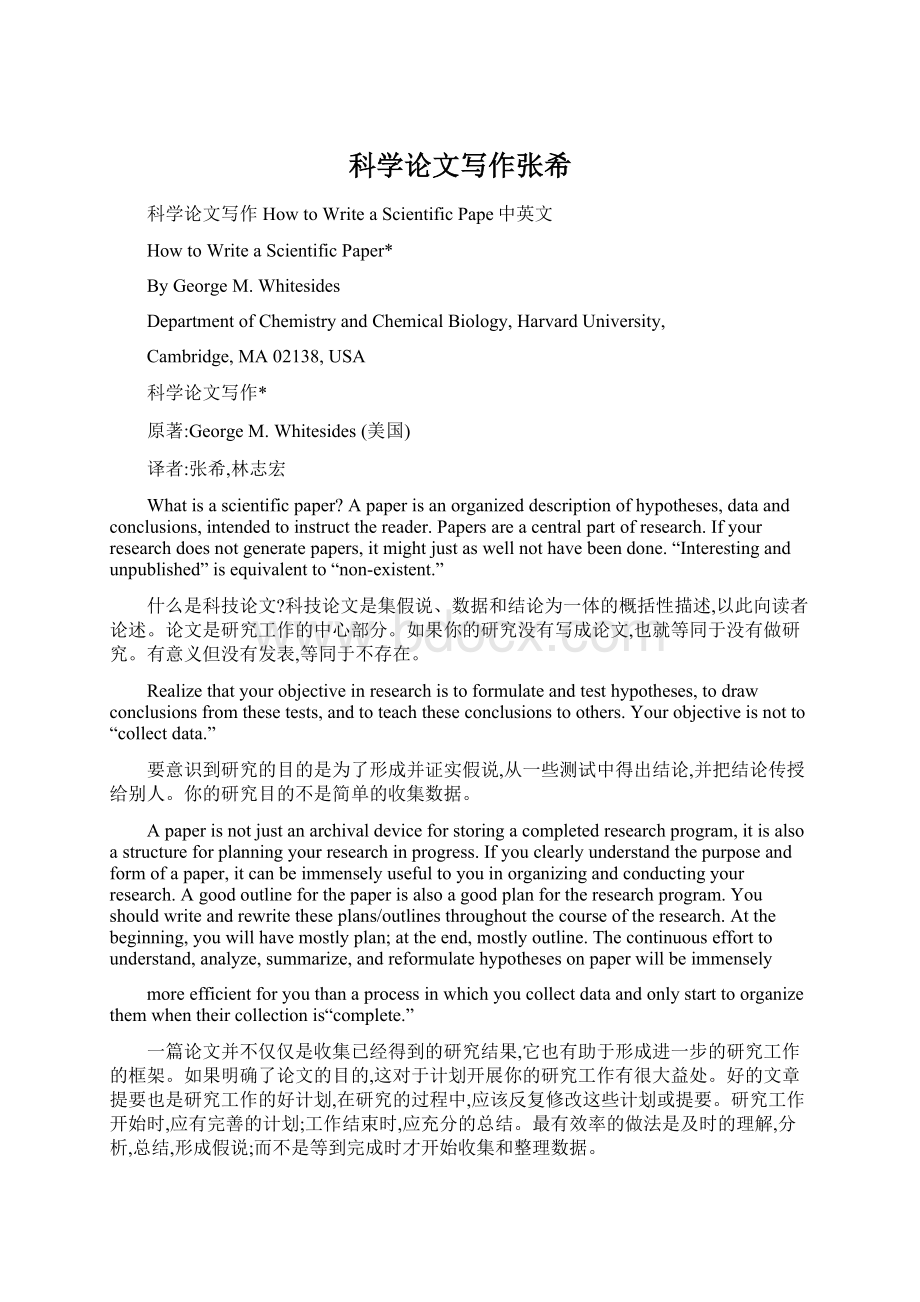科学论文写作张希Word格式.docx
《科学论文写作张希Word格式.docx》由会员分享,可在线阅读,更多相关《科学论文写作张希Word格式.docx(10页珍藏版)》请在冰豆网上搜索。

Realizethatyourobjectiveinresearchistoformulateandtesthypotheses,todrawconclusionsfromthesetests,andtoteachtheseconclusionstoothers.Yourobjectiveisnotto“collectdata.”
要意识到研究的目的是为了形成并证实假说,从一些测试中得出结论,并把结论传授给别人。
你的研究目的不是简单的收集数据。
Apaperisnotjustanarchivaldeviceforstoringacompletedresearchprogram,itisalsoastructureforplanningyourresearchinprogress.Ifyouclearlyunderstandthepurposeandformofapaper,itcanbeimmenselyusefultoyouinorganizingandconductingyourresearch.Agoodoutlineforthepaperisalsoagoodplanfortheresearchprogram.Youshouldwriteandrewritetheseplans/outlinesthroughoutthecourseoftheresearch.Atthebeginning,youwillhavemostlyplan;
attheend,mostlyoutline.Thecontinuousefforttounderstand,analyze,summarize,andreformulatehypothesesonpaperwillbeimmensely
moreefficientforyouthanaprocessinwhichyoucollectdataandonlystarttoorganizethemwhentheircollectionis“complete.”
一篇论文并不仅仅是收集已经得到的研究结果,它也有助于形成进一步的研究工作的框架。
如果明确了论文的目的,这对于计划开展你的研究工作有很大益处。
好的文章提要也是研究工作的好计划,在研究的过程中,应该反复修改这些计划或提要。
研究工作开始时,应有完善的计划;
工作结束时,应充分的总结。
最有效率的做法是及时的理解,分析,总结,形成假说;
而不是等到完成时才开始收集和整理数据。
Thereasonforoutlines.Iemphasizethecentralplaceofanoutlineinwritingpapers,preparingseminars,andplanningresearch.Iespeciallybelievethatforyou,andforme,itismostefficienttowritepapersfromoutlines.Anoutlineisawrittenplanoftheorganizationofapaper,includingthedataonwhichitrests.Youshould,infact,thinkofanoutlineasacarefullyorganizedandpresentedsetofdata,withattendantobjectives,hypothesesandconclusions,ratherthananoutlineoftext.
为什么要写提纲?
我在这里要强调提纲在论文写作,准备报告以及研究计划中的重要作用。
我尤其相信按照提纲进行写作对我们大家都是最有效的方法。
提纲是一篇论文的行文计划,应该包括论文所依靠的数据。
事实上,提纲不仅仅是列出各段的内容,而是按照目的,假说,结论来精心组织数据。
Anoutlineitselfcontainslittletext.IfyouandIcanagreeonthedetailsoftheoutline(thatis,onthedataandorganization),thesupportingtextcanbeassembledfairlyeasily.Ifwedonotagreeontheoutline,anytextisuseless.Muchofthetimeinwritingapapergoesintothetext;
mostofthethoughtgoesintotheorganizationofthedataandintotheanalysis.Itcanberelativelyefficienttogothroughseveral(evenmany)cyclesofanoutlinebeforebeginningtowritetext;
writingmanyversionsofthefulltextofapaperisslow.
提纲本身应该文字简练。
如果大家都同意提纲中的细节部分,那么正文组织起来就更容易。
在我们就提纲达成一致以前,写正文是没有意义的。
写文章时,大部份时间花在写正文上;
而大部份思考是用在整理和分析数据。
在动笔前,详细讨论几遍写作提纲会提高写作效率;
写很多遍正文反倒很慢。
AllthewritingthatIdo-papers,reports,proposals(and,ofcourse,slidesforseminars)-Idofromoutlines.Iurgeyoutolearnhowtousethemaswell.
我写的所有文章,包括论文,报告,建议(当然还有讨论会的胶片)都从提纲开始。
我也希望你们能学会使用它。
Howshouldyouconstructanoutline?
Theclassicalapproachistostartwithablankpieceofpaper,andwritedown,inanyorder,allimportantideasthatoccurtoyouconcerningthepaper.Askyourselftheobviousquestions:
“WhydidIdothiswork?
”“Whatdoesitmean?
”“WhathypothesisdidImeantotest?
”“WhatonesdidIactuallytest?
”“Whatweretheresults?
”“Didtheworkyieldanewmethodorcompound?
What?
”“WhatmeasurementsdidImake?
”“Whatcompounds?
Howweretheycharacterized?
”Sketchpossibleequations,figures,andschemes.Itisessentialtotrytogetthemajorideaswrittendown.Ifyoustarttheresearchtotestonehypothesis,anddecide,whenyouseewhatyouhave,thatthedatareallyseemtotestsomeotherhypothesisbetter,don'
tworry.Writethembothdown,andpickthebestcombinationsofhypotheses,objectivesanddata.Oftentheobjectivesofapaperwhenitisfinishedaredifferentfromthoseusedtojustifystartingthework.Muchofgoodscienceisopportunisticandrevisionist.
你应该如何起草你的提要?
最经典的方法就是找一页空白的纸,以任何顺序,写下与这篇文章有关的所有重要观点。
自问一些显而易见的问题:
为什么我要做这项工作?
它意味着什么?
我要验证哪些假设?
我究竟验证了哪些假设?
结果如何?
这项工作产生了新方法或新物质吗?
都是什么?
我都做了那些测试?
什么化合物?
它们是如何表征的?
展示相关的方程,图表和示意图。
试着写出主要的观点。
如果你的研究开始是为证实一个假设,然而当你发现你有的数据仿佛真的可以更好地验证其它的假设时,你也不必担心。
把它们两者都写出来,去选择假设,目的和数据的最佳组合。
时常,当一篇文章完成时,它的目的和开始时是不同的。
许多好的科学来自机遇和反复修正。
Whenyouhavewrittendownwhatyoucan,startwithanotherpieceofpaperandtrytoorganizethejumbleofthefirstone.Sortallofyourideasintothreemajorheaps(A-C).当你已经写下你能写的,再拿出一页纸,试着草拟一份提纲。
将你的观点分成三大类(见A,B,C)
A)Introduction
WhydidIdothework?
Whatwerethecentralmotivationsandhypotheses?
A)引言
为什么我要做这件工作,主要的目的和假设是什么?
B)ResultsandDiscussion
Whatweretheresults?
Howwerecompoundsmadeandcharacterized?
Whatwasmeasured?
B)结果和讨论
结果是什么?
化合物是怎样合成与表征的?
测试方法是什么?
C)Conclusions
Whatdoesitallmean?
Whathypotheseswereprovedordisproved?
WhatdidIlearn?
Whydoesitmakeadifference?
C)结论
所有这一切意味着什么?
证实或否定了什么假设?
我学到了什么?
结果为什么与众不同?
Next,takeeachofthesesections,andorganizeitonyetfinerscale.Concentrateonorganizingthedata.Constructfigures,tables,andschemestopresentthedataasclearlyandcompactlyaspossible.Thisprocesscanbeslow-Imaysketchafigure5-10timesindifferentways,tryingtodecidehowitismostclear(andlooksbestaesthetically).
接下来,把每一部分再仔细组织。
尤其是要集中整理数据。
要尽可能把数据以清晰、紧凑的图表来展示。
这个过程也许会慢些。
我可能要用5~10次,而且是以不同的方式,来构思一张图,以便决定怎样它才最清楚(而且看上去更加美观)。
Finally,puteverything—outlineofsections,tables,sketchesoffigures,equations-ingoodorder.
最后,把所有这些—内容的提纲、表格、草图、方程式,排好顺序。
Whenyouaresatisfiedthatyouhaveincludedallthedata(orthatyouknowwhatadditionaldatayouintendtocollect),andhaveaplausibleorganization,givetheoutlinetome.Simplyindicatewheremissingdatawillgo,howyouthink(hypothesize)theywilllook,andhowyouwillinterpretthemifyourhypothesisiscorrect.Iwilltakethisoutline,addmyopinions,suggestchanges,andreturnittoyou.Itusuallytakes4-5repeated
attempts(oftenwithadditionalexperiments)toagreeonanoutline.Whenwehaveagreed,thedataareusuallyin(orcloseto)finalform(thatis,thetables,figures,etc.,intheoutlinewillbethetables,figures,…inthepaper.)
当你已经囊括了所有的数据(或者你明确知道你还需要收集哪些额外的数据),有了一个合理的构架,你对这些都感到满意时,将大纲交给我。
简要地标明哪些地方还缺数据,你认为(或推测)这些数据大概是什么样。
如果你的推测是正确的,你将如何去解释它。
拿到你的大纲后,我将把我的观点,建议反馈给你。
一般,我们需要四或五个来回才能达成一致(中间经常还需要补做一些实验)。
在我们的意见一致后,所有的数据通常以最终(或接近最终的)形式确定下来(也就是说,在提纲中的表格,图表等最终将成为文章中的表格,图表)。
Youcanthenstartwriting,withsomeassurancethatmuchofyourprosewillbeused.
然后,你就可以开始动笔写,注意你写的这些大多将用于正文。
Thekeytoefficientuseofyourandmytimeisthatwestartexchangingoutlinesandproposalsasearlyinaprojectaspossible.Donot,underanycircumstances,waituntilthecollectionofdatais“complete”beforestartingtowriteanoutline.Noprojectisevercomplete,anditsavesenormouseffortandmuchtimetoproposeaplausiblepaperandoutlineassoonasyouseethebasicstructureofaproject.Evenifwedecidetodosignificantadditionalworkbeforeseriouslyorganizingapaper,theeffortofwritinganoutlinewillhavehelpedtoguidetheresearch.
合理使用我们的时间的关键是,我们应尽可能早地交换提纲和建议。
在任何情况下,都不要等到你已经收集“全”了数据之后才开始动笔写提纲。
研究是永无止境的。
当你看到你的结果初具雏形时,就要立即开始准备构思文章和提纲,这将节省你很多的精力和时间。
即便在认真组织成文前,我们已经决定补做重要的其他实验,试着写一个提纲也一定对研究有指导意义。
Theoutline
提纲
Whatshouldanoutlinecontain?
提纲需要包括哪些内容?
Title:
Authors:
Abstract:
Donotwriteanabstract.Thatcanbedonewhenthepaperiscomplete.
标题:
作者:
摘要:
不要着急写摘要,可以等文章写完后再写。
Introduction:
Thefirstparagraphortwoshouldbewrittenoutcompletely.Payparticularattentiontotheopeningsentence.Ideally,itshouldstateconciselytheobjectiveofthework,andindicatewhythisobjectiveisimportant.
引言:
文章的第1或2段应该完全用来写引言。
要特别注意写好开头一句话。
最好是简洁地陈述工作的目的,并指明该工作为什么重要。
Ingeneral,theIntroductionshouldhavetheseelements:
Theobjectivesofthework.
Thejustificationfortheseobjectives:
Whyistheworkimportant?
Background:
Whoelsehasdonewhat?
How?
Whathavewedonepreviously?
Guidancetothereader.Whatshouldthereaderwatchforinthepaper?
Whataretheinterestinghighpoints?
Whatstrategydidweuse?
一般而言,引言应该包含以下几个要素:
工作目的。
对工作目的评价:
该工作为什么很重要?
工作背景:
谁做了什么工作?
做得怎么样?
以前我们做了哪些工作?
导读:
读者应该注意该文章的哪些方面?
有意义的要点有哪些?
我们用到了哪些策略?
Summaryconclusion.Whatshouldthereaderexpectasconclusion?
Inadvancedversionsoftheoutline,youshouldalsoincludeallthesectionsthatwillgointheExperimentalsection(atthispoint,justasparagraphsubheadings).
总结结论。
读者期望什么样的结论呢?
在提纲的前几个版本中,你应该包括实验部分中涉及到的所有内容。
(在这一点上,就像是段落的副标题)。
ResultsandDiscussion.Theresultsanddiscussionareusuallycombined.Thissectionshouldbeorganizedaccordingtomajortopics.Theseparatepartsshouldhavesubheadingsinboldfacetomakethisorganizationclear,andtohelpthereaderscanthroughthefinaltexttofindthepartsthatinteresthimorher.Thefollowinglistincludesexamplesofthephrasesthatmightplausiblyserveassectionheadings:
结果和讨论。
通常,结论和讨论是合在一起的。
这一部分应根据主题来进行组织。
分段应有黑体字的副标题,目的是使文章更有条理,能帮助读者清楚地通览全文,并找到他们感兴趣的内容。
下面列举一些适合作副标题的短语:
SynthesisofAlkaneThiols
烷基硫醇的合成
CharacterizationofMonolayers
单层膜的表征
AbsoluteConfigurationoftheVicinalDiolUnit
邻二醇单元的绝对构像
HysteresisCorrelateswithRoughnessoftheSurface
滞后现象与表面粗糙度的关系
DependenceoftheRateConstantonTemperature
温度对速率常数的影响
TheRateofSelf-ExchangeDecreaseswiththePolarityof